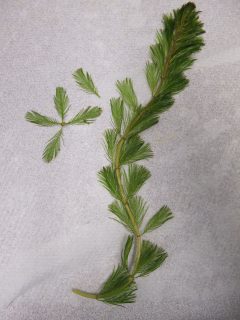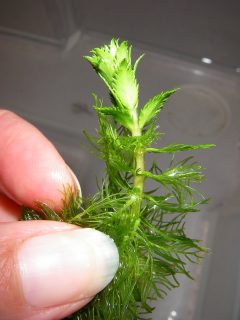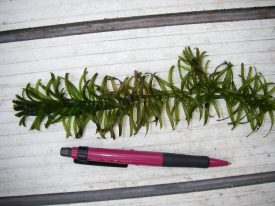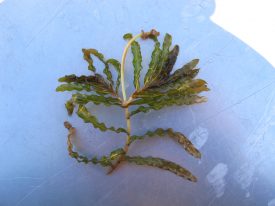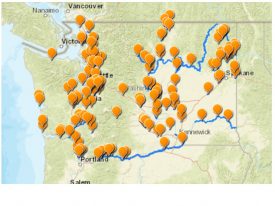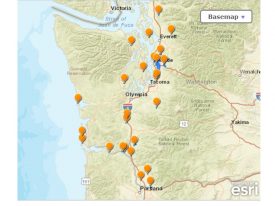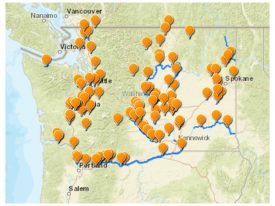Many non-native aquatic plants have been introduced to freshwater lakes and rivers in the Northwest over the last century or more. Some have naturalized and do not cause obvious problems. Others are invasive and dominate native plant communities by growing extremely densely or by growing to the surface and shading out lower growing native species. These invasive non-native plants can cause drastic changes to aquatic ecosystems, as well as headaches for resource managers and recreational boaters and swimmers. A brief overview of these interlopers is provided here, focusing on submersed species. All are on the state noxious weed list and are currently illegal to sell or transport in Washington.
Eurasian watermilfoil (Myriophyllum spicatum) (EWM) is the most well-known and one of the most common submersed aquatic weeds. The first known record of EWM is from Lake Meridian, near Seattle, in 1965. Since then, the weed has spread to well over 100 lakes, many rivers and several streams. It is often spread by boats and boat trailers, and is the most common invasive species found at boat inspection stations. Research has more recently identified hybrids of Eurasian watermilfoil with the native northern milfoil. Some of these hybrids can be more problematic than Eurasian watermilfoil, as they grow faster and are more tolerant to herbicides. Many lakes with Eurasian watermilfoil have been successfully managed, and with persistence, some lake communities have eradicated this weed.
Variable-leaf watermilfoil (Myriophyllum heterophyllum) is native to the Midwestern US. It was sold as an aquarium plant for many years, probably taking the place of Eurasian watermilfoil once that was taken off the market. Luckily this invader is now also off the market in Washington, because it grows more densely and is harder to manage. It was first noticed in a few lakes near Olympia in the 1990’s, but was mis-identified due to its extreme similarity to the native western watermilfoil (Myriophyllum hippuroides). Only when genetic analysis became available for watermilfoil species was variable-leaf watermilfoil correctly identified. At that time, suspected populations were analyzed, and we found it was present in five lakes. The Washington Department of Ecology (Ecology) decided this plant should be a high priority species for eradication, and we are slowly making progress toward that goal.
Brazilian egeria (Egeria densa) (also called Brazilian elodea or just egeria) is native to South America, and was sold for many years as an aquarium plant. It was first discovered in the United States in 1893 in New York. In Washington, it has been growing in Long Lake in Kitsap County since at least the early 1970’s. Currently it is found in about 20 Western Washington lakes and rivers, including Lakes Washington and Sammamish, the Chehalis River, and sloughs along the lower Columbia River. Because the locations are widely distributed, most introductions likely resulted from separate aquarium releases. This plant is more difficult to kill than Eurasian watermilfoil, though control and even eradication has been achieved in a few lakes.
Fanwort (Cabomba caroliniana) is native to the southeastern United States and South America. It was also once a popular aquarium plant, but is now banned from sale in Washington. It is established in sloughs of the lower Columbia River, and also causes problems in several of Oregon’s coastal lakes. Despite its sub-tropical origin, fanwort is cold hardy and can persist where lakes routinely freeze in the winter. It can tolerate a wide range of water quality, but thrives in lakes that are slightly acidic and low in calcium. This could be why it is more common in coastal lakes in the Northwest.
Curly-leaf pondweed (Potamogeton crispus) is native to Europe, Asia and Australia. It is widely distributed in Washington as well as most of North America. It makes burr-like dormant buds that sprout to create clones, which has facilitated its spread. Curly-leaf pondweed has caused a lot of problems in Midwestern lakes, but in Washington its impact varies, with its presence problematic in some areas, but not others. There are many native pondweed species, but its wavy leaf margins and the burrs make curly-leaf pondweed distinctive and relatively easy to spot.
For more information on any of these species, see the State Noxious Weed Board website http://www.nwcb.wa.gov/. You can also use this website: https://fortress.wa.gov/ecy/coastalatlas/tools/LakeDetail.aspx to search aquatic plant data for particular lakes.
If you have additional questions, feel free to contact Jenifer Parsons, Ecology, at jenp461@ecy.wa.gov or 509-457-7136.


